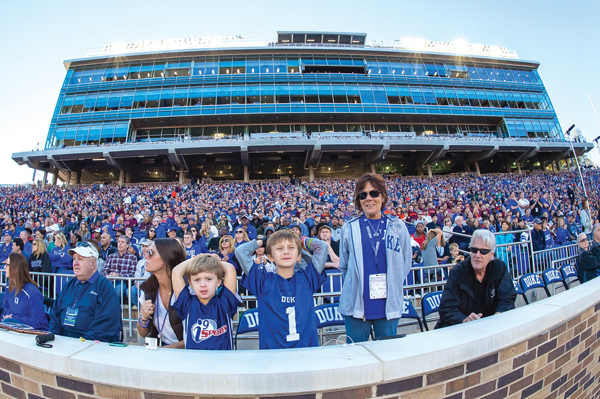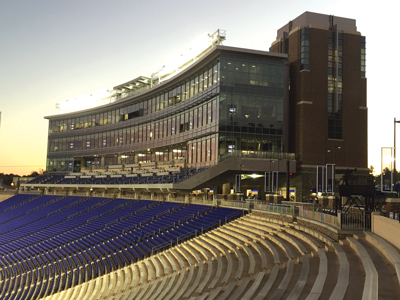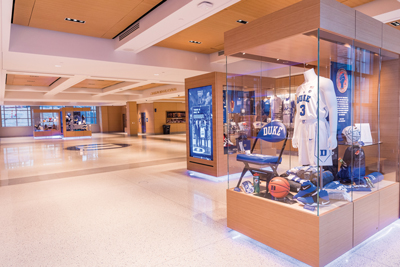 |
One of the major components of Duke’s facilities master plan was the Blue Devil Tower, a five-story addition to Wallace Wade Stadium that added 24 suites and 650 club seats.
Photo by: JIM SHORN
|
 |
Photo by: MICHAEL SMITH / STAFF
|
Long before it was known as a pre-eminent basketball school, Duke University built a football stadium in 1929 so nice that Alabama’s coach left his national championship team a year later to coach the Blue Devils.
The school eventually named the stadium after Wallace Wade, but in many ways time stood still around the old horseshoe, while other schools built modern-day cathedrals to football.
Duke mostly was a casual observer of the facility arms race, which was fine for venerable and historic Cameron Indoor Stadium. Wallace Wade Stadium, on the other hand, was just old and outdated, producing none of the precious premium revenue that schools in the power five have come to rely on.
Finally, now, the long-discussed — six years in the making — and highly anticipated $100 million-plus transformation of Duke’s athletics campus has come to life. The Dallas-based Beck Group did the design and construction to remake many of the facilities and the spaces between them, most of which opened for football season.
Duke’s master plan included three major components: the Blue Devil Tower with suites and club seats high atop the football stadium; the Champion’s Club hospitality space attached to Cameron; and a brick-paved plaza between the football and basketball venues that would be a gathering spot for fans and replace the sea of unattractive black asphalt that used to stretch from one venue to the other.
“This is the most transformational thing we’ve done. It’s night and day from where we were,” said Mike Cragg, Duke’s deputy athletic director for operations.
Duke AD Kevin White put Cragg, a 30-year veteran at the school, in charge of the facility facelift in 2010, when planning started in earnest, and it’s been his baby ever since. The two-year construction phase began in 2014 and is nearly complete.
“This is our once-in-a-lifetime chance to do it right,” Cragg said. “We’re not going to go back and say, ‘Oh, gosh, we should have done this.’ This is it. That’s why it really was a six-year process. At the end of the day, we’re still a small, private school. We’re not going to go tear something down and do it again. It’s a one-time shot.”
The most dramatic change at 40,000-seat Wallace Wade Stadium came in the form of the new five-story, 90,000-square-foot Blue Devil Tower that stands tall above Duke’s home side. Inside the tower, 24 suites and 650 club seats give the Blue Devils premium space and revenue they’ve never had before.
 |
Club space on the second floor of the Blue Devil Tower converts to athlete training table.
Photo by: DUKE ATHLETICS
|
The 16- and 20-person suites sold out before the season with prices ranging from $42,000 to $55,000 a year. The club seats, which require donations of $1,200 and up, were 80 percent sold going into the Nov. 10 home finale against North Carolina. Those premium spaces alone account for more than $2 million in new annual revenue, and that doesn’t include specialty events on nongame days.
When White entertained guests and donors at Duke football games in previous years, they climbed stairs to the roof of the Finch-Yeager Building and watched from inside a makeshift trailer that was cooled with a window-unit air conditioner. To say that it lacked polish would be an understatement.
Now when White hosts guests like retired Army Gen. Martin Dempsey, the new chairman of USA Basketball, who took in Duke’s stirring 28-27 victory over North Carolina, they gather in a well-appointed suite with two sides of floor-to-ceiling glass that provide a wide-lens 90-degree view from the field to Cameron Indoor Stadium.
“The vision was to have the best small, intimate venue in college football, just like we believe Cameron is the best venue in college basketball,” said Beck Group CEO Fred Perpall, who has worked on several projects, sports and nonsports, at Duke.
A small, private institution of 6,500 undergraduate students in the heart of Tobacco Road, Duke began construction in 2014 with a goal of doing this for $100 million, all raised through private funds. Suffice to say, “that’s an antiquated number,” White said.
While White isn’t ready to reveal the total project cost, which went well north of $100 million, Duke has offset the expenses with a robust fundraising campaign that has brought in $350 million. Much of that came from naming-rights opportunities in the tower and around the field.
Duke has sold eight significant naming-rights deals that start at $10 million and go up. Most, such as the field, were bought by longtime donors and individuals. Only one so far, the Delta Suite Level on the tower’s third floor, was a corporate buy.
One of the most significant pieces of new inventory, naming rights to the overall athletic campus, remains available.
“We’re in the right place for Duke,” White said. “We need to be aspirational and we need to move into the future, but we need to do it in a Duke way. I think we managed that.”
Nowhere is the “Duke way” more evident than in Cameron Indoor Stadium. White has intentionally left the bowl of the small, charming arena — capacity 9,314 — largely like he found it when he left Notre Dame for the Duke AD job in 2008. But the Blue Devils have discovered ways to enhance the building that surrounds the bowl with several new initiatives.
 |
Displays at Rubenstein Pavilion
Photo by: DUKE ATHLETICS
|
Earlier this year, Duke completed an addition, similar to the extension Kansas built to Allen Fieldhouse, that gave Cameron a new two-story front called Rubenstein Pavilion. On the second floor is the Champion’s Club, a high-end hospitality space for football and basketball pregame events, as well as weddings, corporate events and other functions that tap into the mystique of being at one of college basketball’s most iconic venues.
The Colonnade Group from Birmingham, Ala., manages and services all of the premium spaces, from the Blue Devil Tower to the Champion’s Club.
Much of the motivation for enhancing the perimeter of Cameron came from a trip to Spain in 2014 with Team USA basketball, which was coached by Duke’s Mike Krzyzewski. Duke’s administrators on the trip toured soccer stadiums such as FC Barcelona’s Camp Nou to see how older venues had been preserved. That’s where they picked up ideas to modernize the outer rim of Cameron with interactive touch-screen displays and exhibits, without compromising the unique game atmosphere inside the bowl.
“It has to look like, smell like, taste like the rest of the university,” White said. “We can’t look dissimilar to the rest of the place. We’re in line with the distinctive image of the university, and that’s something we’re very proud of.”







